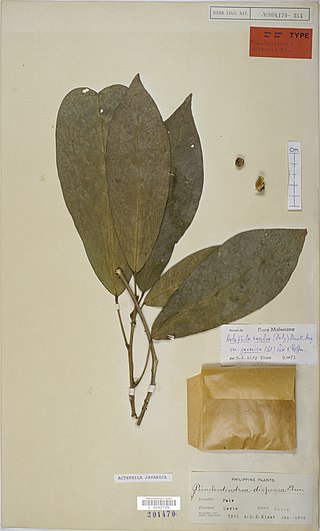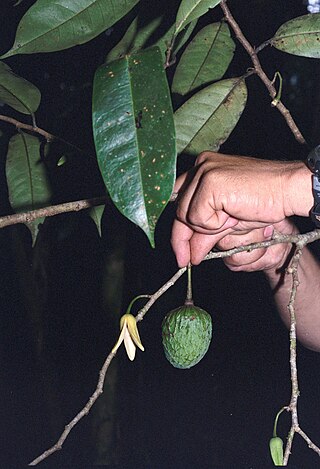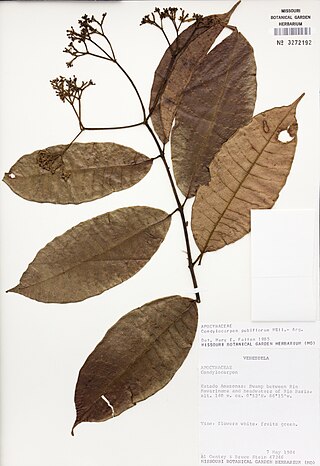
Quercus montana, the chestnut oak, is a species of oak in the white oak group, Quercus sect. Quercus. It is native to the eastern United States, where it is one of the most important ridgetop trees from southern Maine southwest to central Mississippi, with an outlying northwestern population in southern Michigan. It is also sometimes called rock oak because of its presence in montane and other rocky habitats.

Plumeria, also known as frangipani, is a genus of flowering plants in the subfamily Rauvolfioideae, of the family Apocynaceae. Most species are deciduous shrubs or small trees. The species are native to the Neotropical realm, but are often grown as cosmopolitan ornamentals in tropical regions, especially in Hawaii, as well as hot desert climates in the Arabian Peninsula with proper irrigation.

Polyscias racemosa, or false 'ohe, is a species of flowering plant in the family Araliaceae. As Munroidendron racemosum, the species was until recently considered to be the only species in the monotypic genus Munroidendron. With the change in classification, Munroidendron is now obsolete. Polyscias racemosa is endemic to the Hawaiian island of Kauai. It is very rare in the wild and some of its original habitat has been replaced by sugar cane plantations. It was thought for some time to be probably extinct, but was rediscovered a few years prior to 1967.

Codiaeum variegatum is a species of Codiaeum, a genus of flowering plants, in the Euphorbiaceae. Initially described by Carl Linnaeus in 1753, it is native to Australasia and Oceania, from Malaysia and Indonesia in the north through northeastern Australia, as well as many Southeast Asian and South Pacific islands, growing in open forests and scrub.

Actephila excelsa is a species of shrub in the family Phyllanthaceae. It is native to an area in Tropical Asia and Zhōngguó/China, from Sulawesi to India and Guangxi. It is a highly variable species and leaf forms vary across adjacent ecozones. The plant is used in building houses and as a vegetable. Grey-shanked douc langurs eat the leaves.

Pausandra is a plant genus of the family Euphorbiaceae first described in 1870. It is native to Central America and South America.
- Pausandra fordiiSecco - Amapá, French Guiana
- Pausandra hirsutaLanj. - Peru, Brazil, Bolivia (Pando), Colombia (Amazonas)
- Pausandra macropetalaDucke - Brazil, Peru (Loreto), Venezuela (Amazonas)
- Pausandra macrostachyaDucke - Pará
- Pausandra martiniBaill. - French Guiana, Suriname, Guyana, Colombia, Venezuela, Peru, Brazil
- Pausandra megalophyllaMüll.Arg. - Rio de Janeiro
- Pausandra morisiana(Casar.) Radlk. - Brazil
- Pausandra trianae(Müll.Arg.) Baill. - widespread from Honduras to Bolivia

Hypericum przewalskii, commonly called Przewalski's St. John's wort, is a flowering plant in Hypericumsect. Roscyna that is native to China.

Annona pittieri is a species of plant in the family Annonaceae. It is native to Costa Rica and Panamá. John Donnell Smith, the American taxonomist who first formally described the species, named it after Henri François Pittier, the Swiss botanist who collected specimen he examined.

Drypetes arguta, commonly known as the water ironplum, is a species of small tree or large bush in the family Putranjivaceae. It is native to tropical East Africa. It was first described in 1920 by the English botanist John Hutchinson, who named it Cyclostemon argutus. It was later transferred to the genus Drypetes.

Drypetes gerrardii is a species of small tree or large shrub in the family Putranjivaceae. Common names include forest ironplum, bastard white ironwood, and forest ironwood. It is native to tropical and subtropical central and eastern Africa. It was first described in 1920 by the English botanist John Hutchinson, who named it after the English botanist William Tyrer Gerrard who collected plants and seeds in southern Africa in the 1860s.

Antidesma japonicum is a shrub in the family Phyllanthaceae. It is found in Southeast Asia, China and Japan. It provides food and fuel. A. japonicum has two accepted varieties: the nominate variety, A. japonicum var. japonicum; and the robustius variety, A. japonicum var. robustius.
Mallotus floribundus is a tree in the family Euphorbiaceae, in the Stylanthus section, native to Southeast Asia, Wallaceae, New Guinea and the Solomon Islands.

Rhodocactus sacharosa, synonym Pereskia sacharosa, is a species of flowering plant in the cactus family Cactaceae, native from Bolivia and west-central Brazil to Paraguay and northern Argentina. Like all species in the genus Rhodocactus and unlike most cacti, it has persistent leaves. It was first described in 1879.

Phyllobotryon is a genus of flowering plants belonging to the family Salicaceae native to the region spanning from Nigeria to Tanzania and Angola.

Symphyotrichum spathulatum is a species of flowering plant in the family Asteraceae native to western North America including northwestern Mexico. Commonly known as western mountain aster, it is a perennial, herbaceous plant that may reach 20 to 80 centimeters tall. Its flowers, which open in July and August, have violet ray florets and yellow disk florets.

Gerbera ambigua is a species of flowering plant in the section Lasiopus of genus Gerbera belonging to the basal Mutisieae tribe within the large Asteraceae family.

Condylocarpon amazonicum is a species of plant in the Apocynaceae family. It is native to Bolivia, Brazil, Suriname, and Venezuela. Friedrich Markgraf, the botanist who first formally described the species, using the basionym Anechites amazonicus, named it after the area near the Amazon River in Pará Brazil where the specimen he examined was collected by Adolpho Ducke.

Condylocarpon pubiflorum is a species of plant in the Apocynaceae family. It is native to Bolivia, Brazil, Colombia, Peru and Venezuela. Johannes Müller Argoviensis, the botanist who first formally described the species, named it after an invalid nomen nudum, Hortsmania pubiflora, previously offered by George Bentham.

Peperomia truncicola is a species of epiphyte in the genus Peperomia. It primarily grows on wet tropical biomes. Its Conservation Status is Not Threatened.

Glochidion marianum is a species of plant in the family Phyllanthaceae that is endemic to the islands of Guam and the Caroline Islands.




















